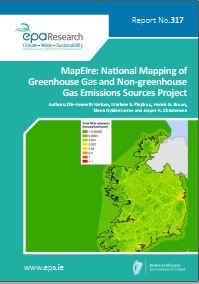Research 317: MapEIre: National Mapping of Greenhouse Gas and Non-greenhouse Gas Emissions Sources Project.
Authors: Ole-Kenneth Nielsen, Marlene S. Plejdrup, Henrik G. Bruun, Steen Gyldenkærne and Jesper H. Christensen
Summary: This research developed a state-of-the-art integrated model system to map emissions for Ireland’s emission inventories of air pollutants and greenhouse gases. Based on a variety of spatial and statistical data, the MapEIre model produced detailed spatial emissions at a resolution of 1 km × 1 km.

The MapEIre model also includes a temporal module that enables the addition of a temporal parameter with a resolution of 1 hour. The detailed sectoral breakdown in the MapEIre model facilitates the identification of emission hotspots and peak hours.
Identifying Pressures
Emissions of air pollutants and greenhouse gases influence the local air quality and the global climate, both of which affect the public. It is crucial to be able to identify the largest emission sources, hotspot locations and peak hours to be able to identify proportions of pressures. This research has produced the first spatial and temporal high-resolution data to allow for a better understanding of exposure to air pollution.
Informing Policy
Regulation of local and national emissions is important to improve air quality and reduce effects on the climate. Spatio-temporal emission mapping is an important tool for targeting measures and documenting improvements over time. Identifying emission hotspots and peak hours allows policymakers to target the regulations and thereby optimise the cost–benefit of measures. The results of this project can help to inform the work on Ireland’s Clean Air Strategy.
Developing Solutions
Developing cost-effective policies and measures depends on the existence of detailed data on spatial and temporal emissions. Knowledge of national and local circumstances is crucial for the preparation of accurate spatio-temporal emissions, which favour the use of national or local models rather than existing regional or global models. Detailed spatial and statistical data should be used as the basis for models to provide the most accurate picture of national and local conditions. Basing policies on less detailed general models constitutes a risk that the measures are not being targeted optimally.
The MapEIre model set-up focuses on user-friendliness, being easy to update as new data become available, such as emissions data, spatial data or temporal data, and thereby provides a useful tool for policymakers. The findings from this research suggest the need to:
- target mitigation actions at areas with significant emissions;
- continuously improve the emission inventories, as well as the spatial and temporal models, to ensure a good basis for developing policies and measures;
- further develop an integrated system in Ireland using the results of this project for air quality modelling and exposure modelling.